Charles E W Bean, Diaries, AWM38 3DRL 606/260/1 - 1916 - 1930 - Part 14
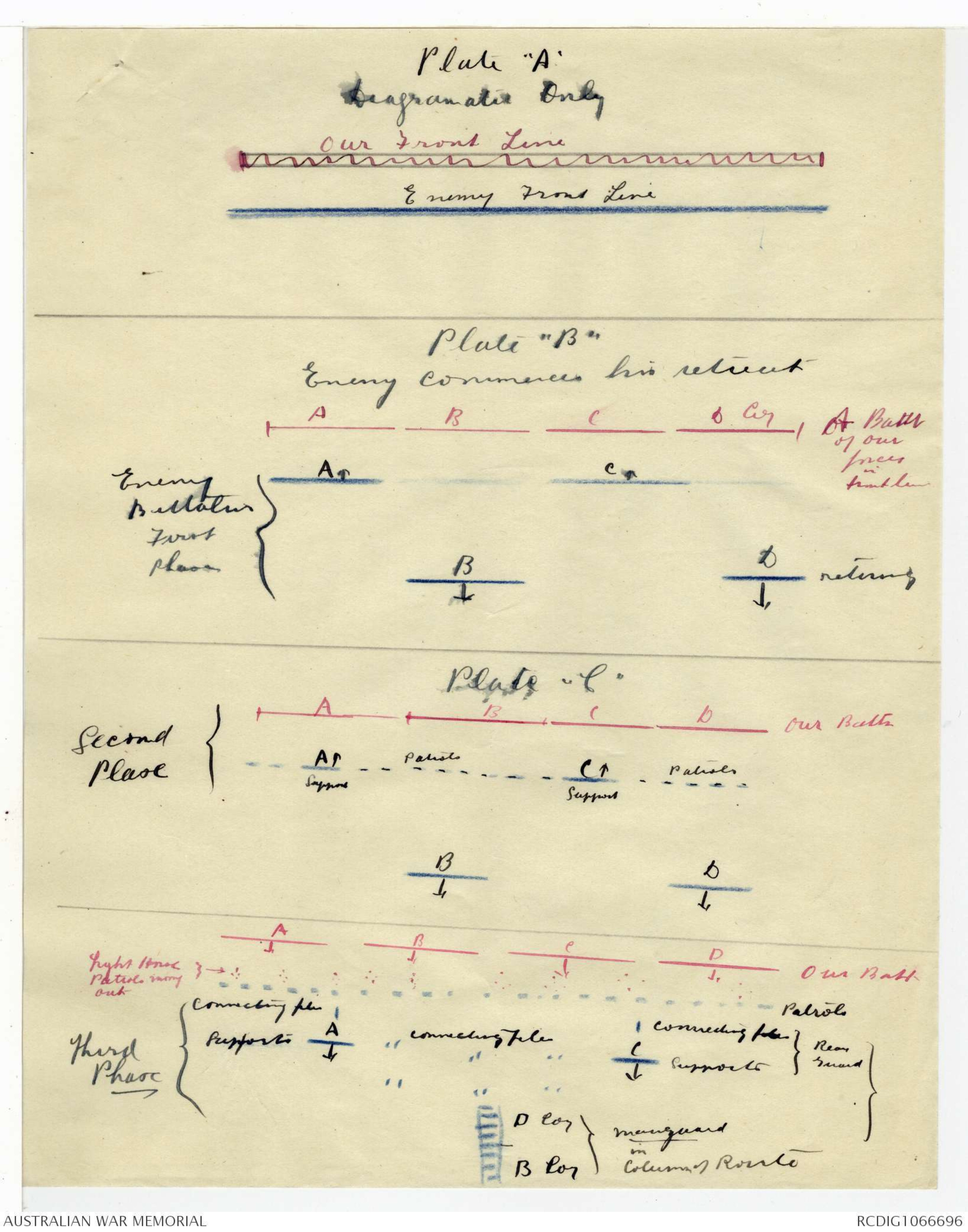
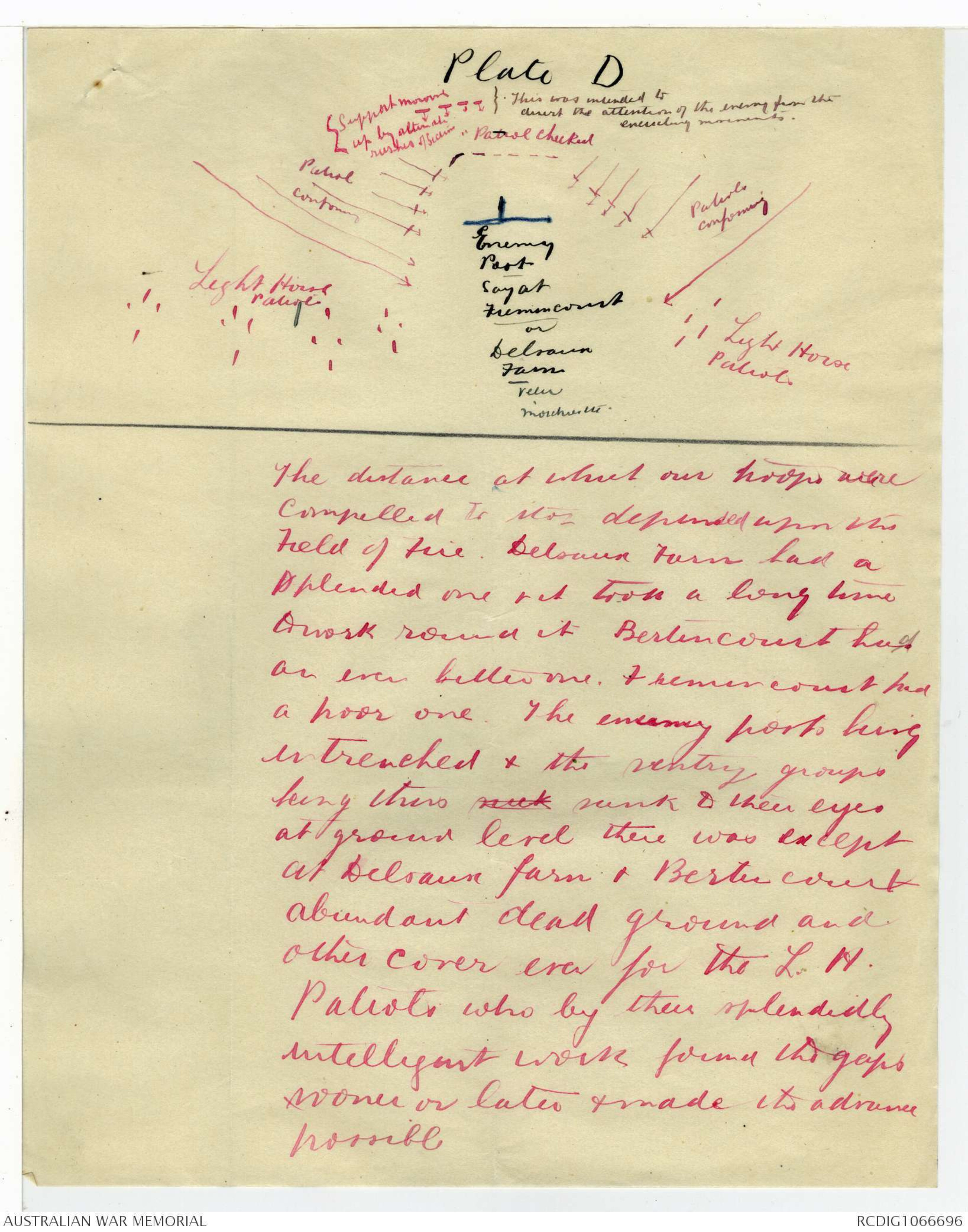
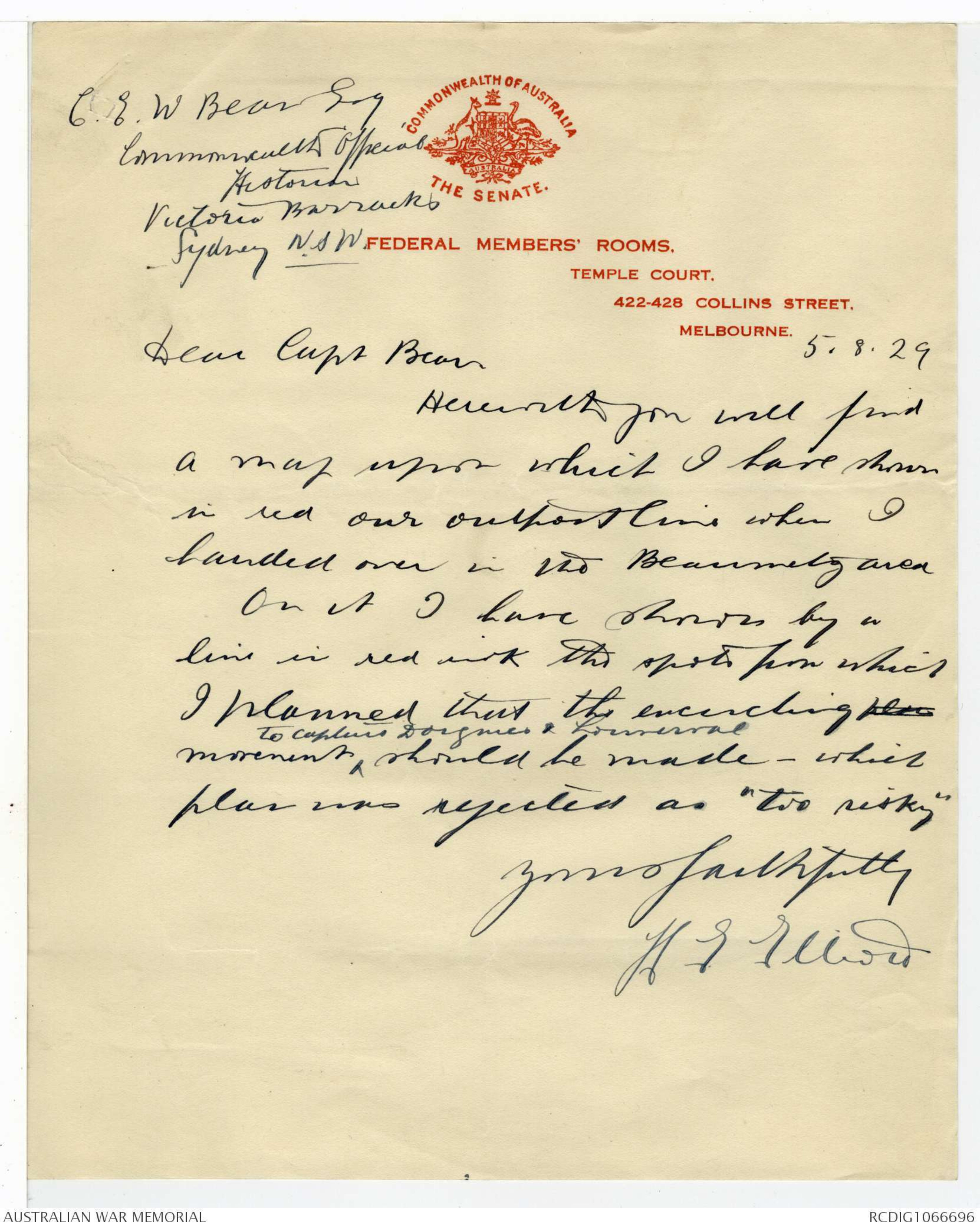
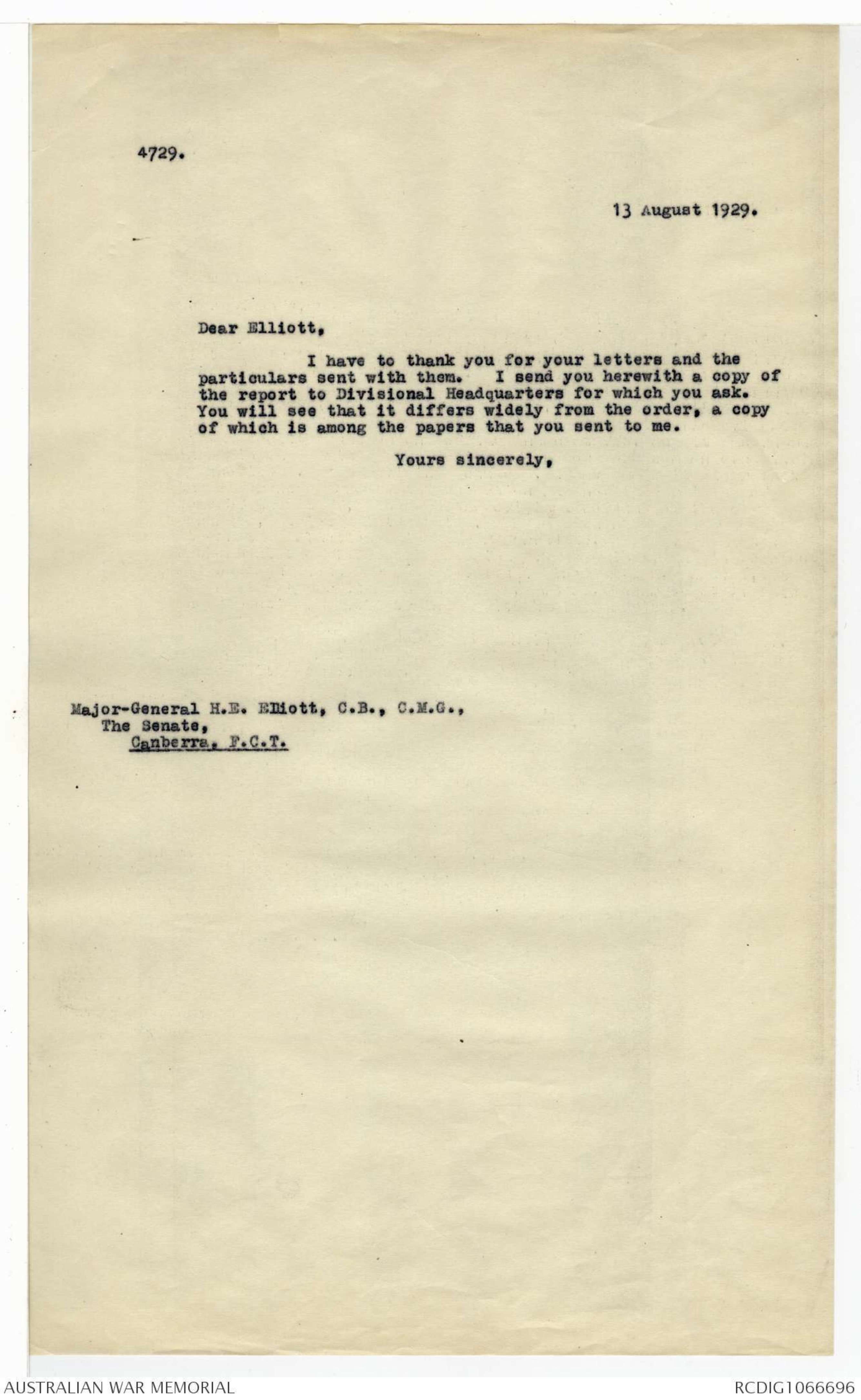

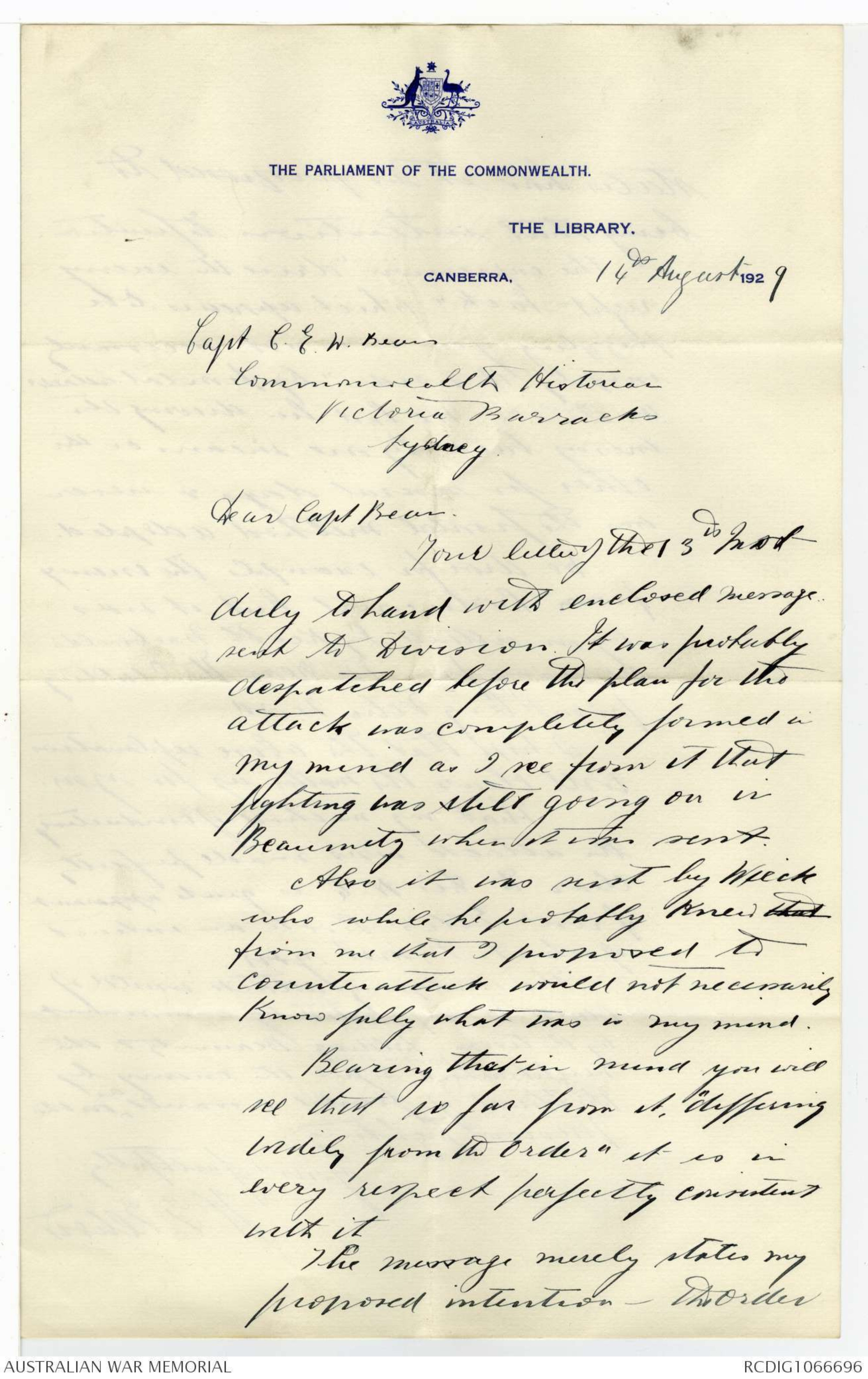
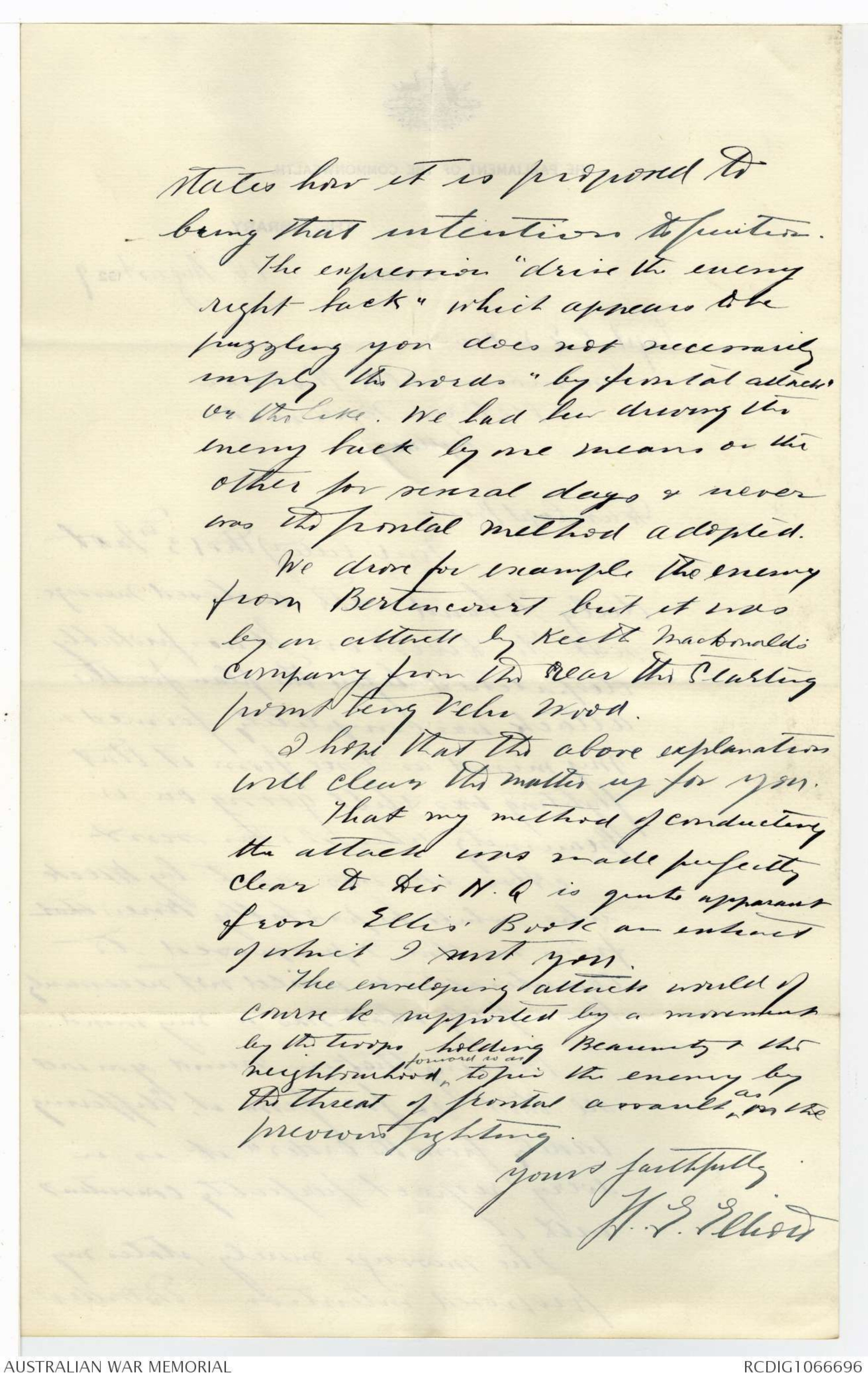
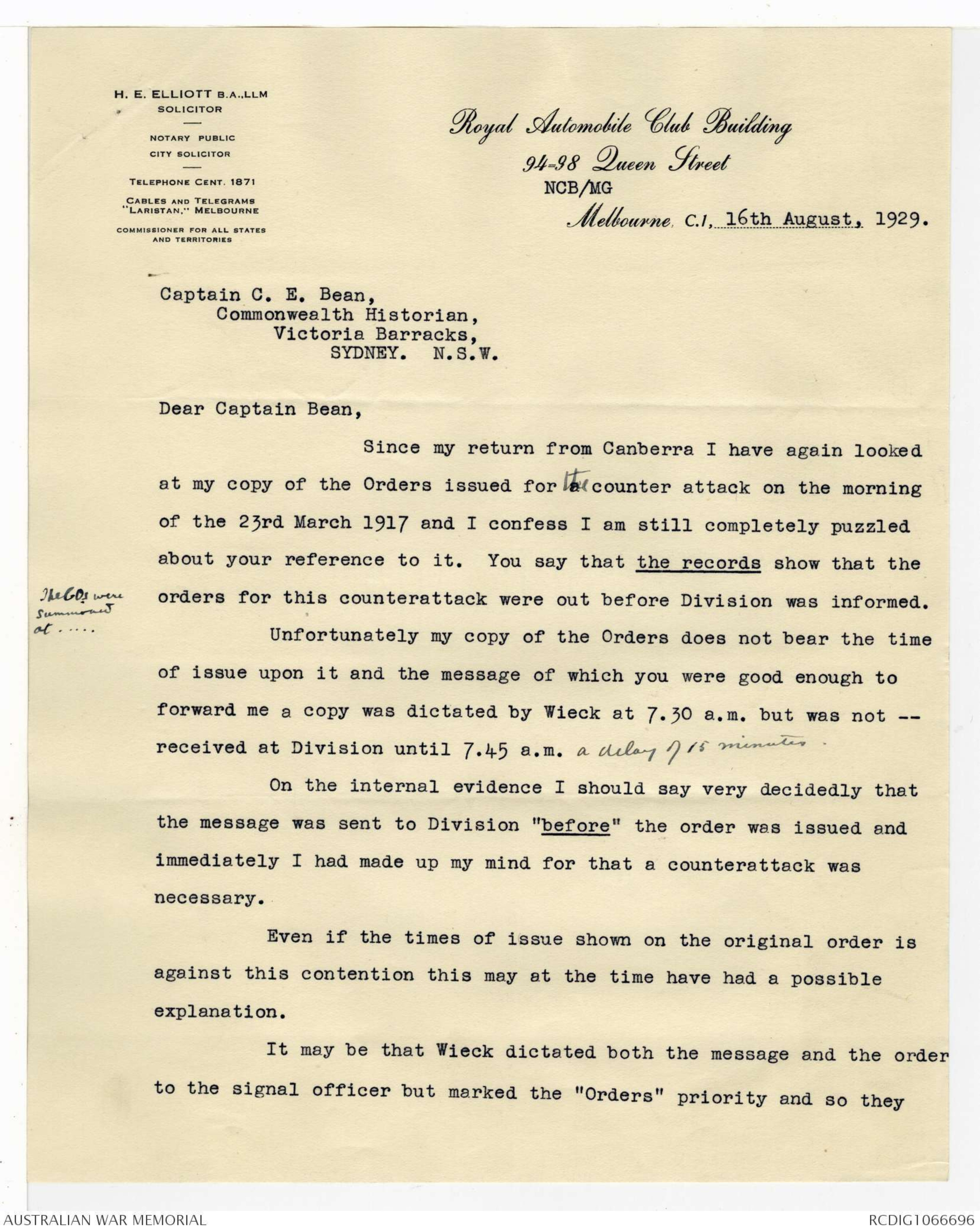
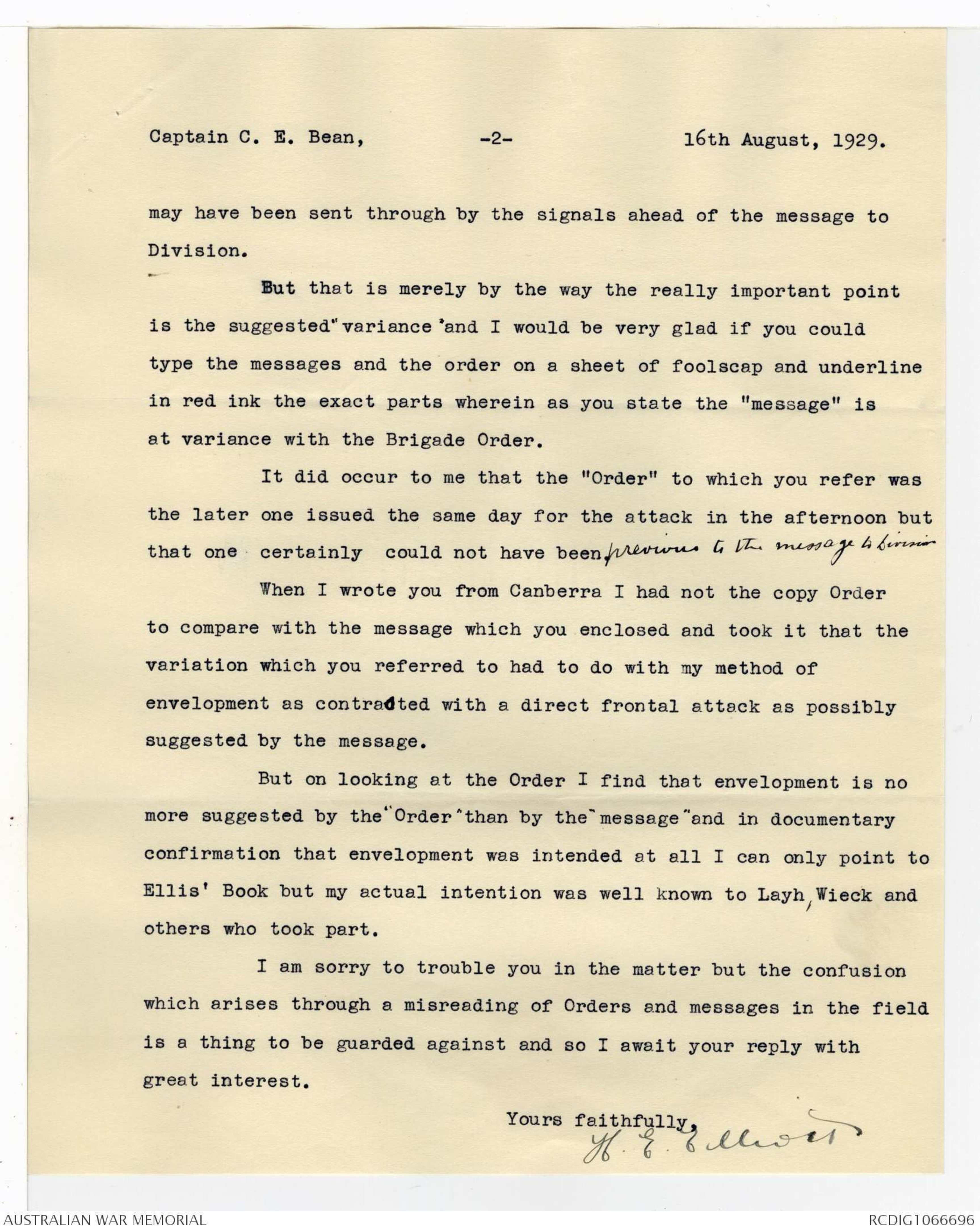
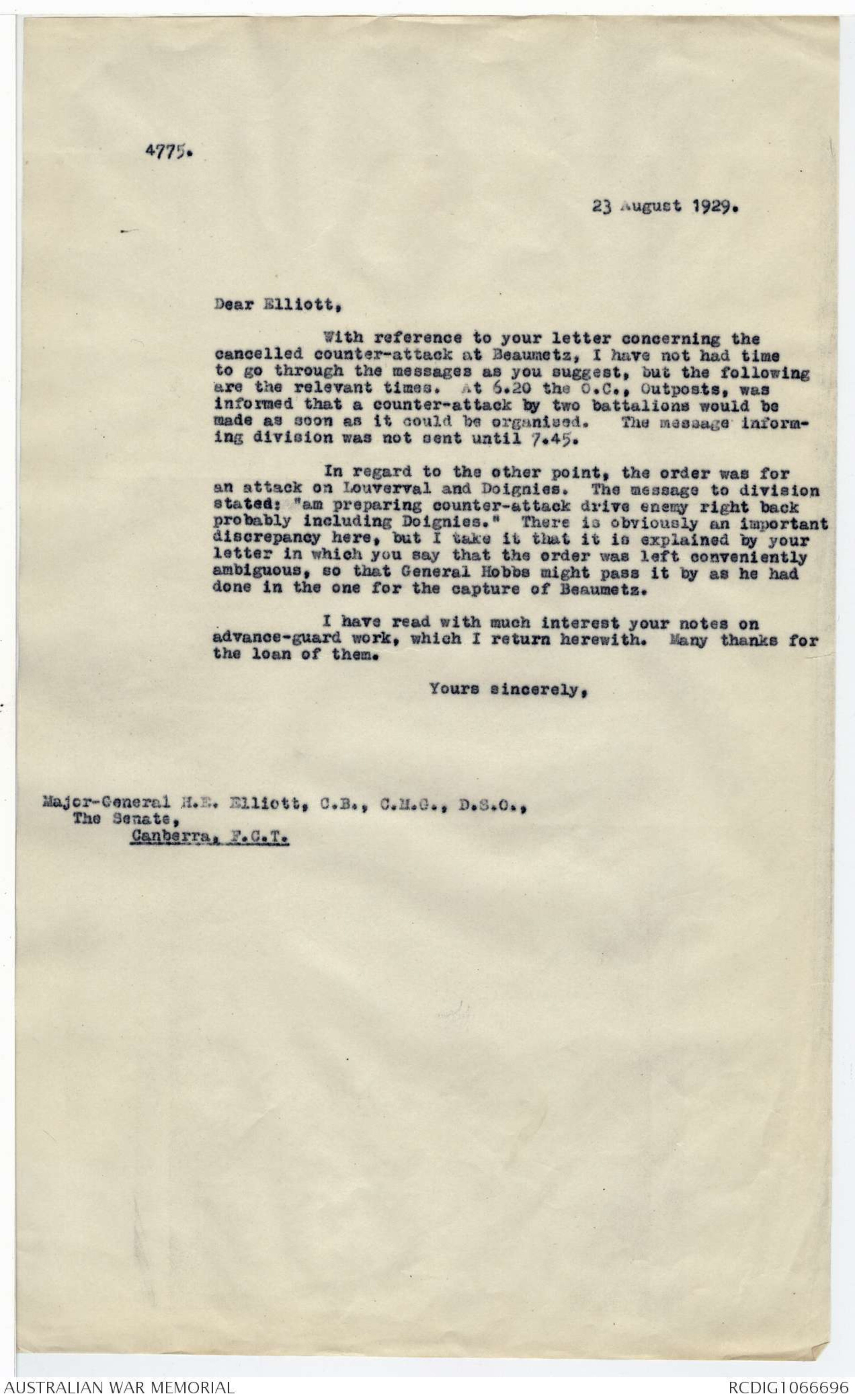
Diagram - see original document
Plate "A"
Plate "B"
Plate "C"
Diagram - see original document
Plate D
The distance at which our troops were
compelled to [[? stop]] depended upon the
field of fire . Delsaux Farm had a
splendid one & it took a long time
to work round it Bertincourt had
an even better one. & Fremicourt had
a poor one. The enemy posts being
entrenched & the sentry groups
being thus suck sunk to their eyes
at ground level there was except
at Delsaux farm & Bertincourt
abundant dead ground and
other cover over for the L.H.
Patrols who by their splendidly
intelligent work found the gaps
sooner or later & made the advance
possible
C.E.W Bean Esq
Commonwealth Official
Historian
Victoria Barracks
Sydney N.S.W
COMMONWEALTH OF AUSTRALIA
THE SENATE.
FEDERAL MEMBERS' ROOMS.
TEMPLE COURT.
422-428 COLLINS STREET.
MELBOURNE.
5.8.29
Dear Capt Bean
Herewith you will find
a map upon which I have shown
in red our outpost line when I
handed over in the Beaumetz area
On it I have shown by a
line in red ink the spot from which
I planned that the encircling pla
movement ^to capture Doignes & Louverval should be made - which
plan was rejected as "too risky"
Yours faithfully
H E Elliott
4729.
13 August 1929.
Dear Elliott,
I have to thank you for your letters and the
particulars sent with them. I send you herewith a copy of
the report to Divisional Headquarters for which you ask.
You will see that 1t differs widely from the order, a copy
of which is among the papers that you sent to me.
Yours sincerely,
Major-General H.E. Elliott, C.B., C.M.G.,
The Senate,
Canberra, F.G.T
COPY.
To TOOLS
B.M. 1/725 23rd 7.30 a.m. AAA
O.C. Outposts reports that Beaumetz practically recovered
AAA Two wounded Germans being brought back AAA Am preparing
counter attack to drive enemy right back probably including
Doignies
From BOOK Geo. F. Wieck, Major.
7.45 a.m
THE PARLIAMENT OF THE COMMONWEALTH.
THE LIBRARY.
CANBERRA.
14th August 1929
Capt C. E. W. Bean
Commonwealth Historian
Victoria Barracks
Sydney
Dear Capt Bean.
Your letter of the 13th inst
duly to hand with enclosed message.
sent to Division. It was probably
despatched before the plan for the
attack was completely formed in
my mind as I see from it that
fighting was still going on in
Beaumetz when it was sent.
Also it was sent by Wieck
who while he probably knew that
from me that I proposed to
counterattack would not necessarily
know fully what was is my mind.
Bearing that in mind you will
see that so far from it "differing
widely from the order" it is in
every respect perfectly consistent
with it
The message merely states my
proposed intention - the order
states how it is proposed to
bring that intention to fruition.
the expression "drive the enemy
right back," which appears to be
puzzling you does not necessarily
imply the words "by frontal attack"
on the lake. We had been driving the
enemy back by one means or the
other for several days & never
was the frontal method adopted.
We drove for example the enemy
from Bertincourt but it was
by an attack by Keith Macdonald's
company from the rear the starting
point being Velu Wood.
I hope that the above explanation
will clear the matter up for you.
That my method of conducting
the attack was made perfectly
clear to Div H.Q is quite apparent
from Ellis' Book an extract
of which I sent you
The enveloping attacks would of
course be supported by a movement
by the troops holding Beaumetz & the
neighbourhood, ^forward as an pin the enemy by
the threat of frontal assault, ^as in the
previous fighting
Yours faithfully
H.E. Elliott
H. E. ELLIOTT B.A.,LLM
SOLICITOR
NOTARY PUBLIC
CITY SOLICITOR
TELEPHONE CENT, 1871
CABLES AND TELEGRAMS
"LARISTAN"- MELBOURNE
COMMISSIONER FOR ALL STATES
AND TERRITORIES
Royal Automobile Club Building
94-38 Queen Street
NCB/MG
Melbourne, C.1, 16th August, 1929.
Captain C. E. Bean.
Commonwealth Historian
Victoria Barracks
SYDNEY. N.S.W.
Dear Captain Bean,
Since my return from Canberra I have again looked
at my copy of the Orders issued for the counter attack on the morning
of the 23rd March 1917 and I confess I am still completely puzzled
about your reference to it. You say that the records show that the
orders for this counterattack were out before Division was informed.
[[*The G.Ds were
summoned
at.....*]]
Unfortunately my copy of the Orders does not bear the time
of issue upon it and the message of which you were good enough to
Forward me a copy was dictated by Wieck at 7.30 a.m. but was not --
received at Division until 7.45 a.m. a delay of 15 minutes.
On the internal evidence I should say very decidedly that
the message was sent to Division "before" the order was issued and
immediately I had made up my mind for that a counterattack was
necessary.
Even if the times of issue shown on the original order is
against this contention this may at the time have had a possible
explanation.
It may be that Wieck dictated both the message and the order
to the signal officer but marked the "Orders" priority and so they
Captain C. E. Bean, -2- 16th August, 1929.
may have been sent through by the signals ahead of the message to
Division.
But that is merely by the way the really important point
is the suggested "variance" and I would be very glad if you could
type the messages and the order on a sheet of foolscap and underline
in red ink the exact parts wherein as you state the "message" is
at variance with the Brigade Order.
It did occur to me that the "Order" to which you refer was
the later one issued the same day for the attack in the afternoon but
that one certainly could not have been previous to the message to Division
When I wrote you from Canberra I had not the copy Order
to compare with the message which you enclosed and took it that the
variation which you referred to had to do with my method of
envelopment as contracted with a direct frontal attack as possibly
suggested by the message.
But on looking at the Order I find that envelopment is no
more suggested by the "Order" than by the "message" and in documentary
confirmation that envelopment was intended at all I can only point to
Ellis’ Book but my actual intention was well known to Layh, Wieck and
others who took part.
I am sorry to trouble you in the matter but the confusion
which arises through a misreading of Orders and messages in the field
is a thing to be guarded against and so I await your reply with
great interest.
Yours faithfully,
H. E. Elliott
4775.
23 August 1929.
Dear Elliott,
With reference to your letter concerning the
cancelled counter-attack at Beaumetz, I have not had time
to go through the messages as you suggest, but the following
are the relevant times. At 6.20 the O.C., Outposts, was
informed that a counter-attack by two battalions would be
made as soon as it could be organised. The message informing
division was not sent until 7.45.
In regard to the other point, the order was for
an attack on Louverval and Doignies. The message to division
stated; "am preparing counter-attack drive enemy right back
probably including Doignies." There is obviously an important
discrepancy here, but I take it that it is explained by your
letter in which you say that the order was left conveniently
ambiguous, so that General Hobbs might pass it by as he had
done in the one for the capture of Beaumetz.
I have read with much interest your notes on
advance-guard work, which I return herewith. Many thanks for
the loan of them.
Yours sincerely,
Major-General H.E. Elliott, C.B., C.M.G., D.S.0.,
The Senate,
Canberra, F.G.T.
 Sam scott
Sam scottThis transcription item is now locked to you for editing. To release the lock either Save your changes or Cancel.
This lock will be automatically released after 60 minutes of inactivity.